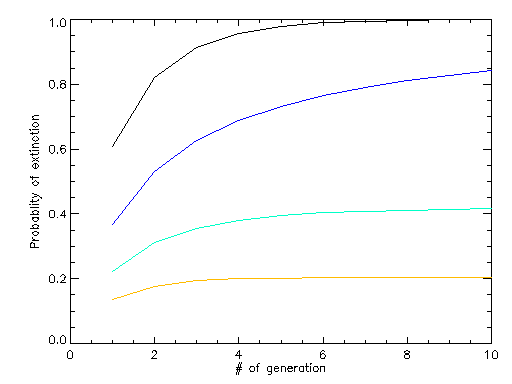最新文章
文章分類
歸檔
2010 (5)
2011 (2)
2013 (42)
2015 (93)
2016 (126)
2017 (121)
2018 (90)
2019 (105)
2020 (233)
2021 (239)
2022 (249)
2023 (295)

正文
Friday, time for stories.
基因消失的機率concerns the theory of extinction.
The parliatmenet of UK has an upper house and a lower house. The upper house consists of, for a good part, the heirs of lords whose ancestors many generations used to fight for the king. Now, each generation, a few of these seats became empty because some of the lords failed to produce a male offspring (new lords were created to fill these seats, but that's not the concern of this story). A study was made by mathematically proficient individuals, so this became the beginning of the extinction theory.
Everybody wishes that his/her gene would pass down generation after generation. Sadly, everybody will become extinct after some generations. A well know example is what happened after the Mutiny of Bounty (a good Oscar movie was made after this story). When the sailors settled on the small island of Pitcairn with their Tahitian beauties, there were 21 surnames. As the island was quite isolated, the inhabitants married between the families. A few generations later, there were only 7 surnames left.
As one might expect, the more children you (and your descendants) have, the less likely you will become extinct.
The number of children each woman has (the fertility) is roughly a Poisson distribution,
p(n,a) = (1/n!) a^n*exp(-a), a being the average number of children each woman has.
If a woman has no children, she becomes extinct (the first generation). However, she can become extinct if none of her children or grandchildren, etc have any children. If I call p(m,a) the probability of extinction at generation m, then:
p(1,a)=exp(-a);
p(2,a)=sum p(n,a)*(p(1,a))^n (because all children has to be childless)
=sum (1/n!) a^n*exp(-a) * p(1,a)^n
=sum (1/n!) (a*p(1,a))^n exp(-a)
=exp(-a(1-p(1,a)))....
This can be generalized to:
p(m,a)=exp(-a(1-p(m-1,a))) !
OK, now we can plug in some numbers....

The plot above shows the probablity of extinction of the male line with average fertility of 1, 2, 3 and 4 offsprings from top to bottom. If there is only one child on average, then by the 4th generation you will 95% die off. If you have two, being likely to have one a boy, then you can delay that demise to much later (20% still around after 10 generations). But if you have 3, you are ok if you can survive the first 3 generations because by then you would have a good number of descendants walking or crawling around...
基因消失的機率concerns the theory of extinction.
The parliatmenet of UK has an upper house and a lower house. The upper house consists of, for a good part, the heirs of lords whose ancestors many generations used to fight for the king. Now, each generation, a few of these seats became empty because some of the lords failed to produce a male offspring (new lords were created to fill these seats, but that's not the concern of this story). A study was made by mathematically proficient individuals, so this became the beginning of the extinction theory.
Everybody wishes that his/her gene would pass down generation after generation. Sadly, everybody will become extinct after some generations. A well know example is what happened after the Mutiny of Bounty (a good Oscar movie was made after this story). When the sailors settled on the small island of Pitcairn with their Tahitian beauties, there were 21 surnames. As the island was quite isolated, the inhabitants married between the families. A few generations later, there were only 7 surnames left.
As one might expect, the more children you (and your descendants) have, the less likely you will become extinct.
The number of children each woman has (the fertility) is roughly a Poisson distribution,
p(n,a) = (1/n!) a^n*exp(-a), a being the average number of children each woman has.
If a woman has no children, she becomes extinct (the first generation). However, she can become extinct if none of her children or grandchildren, etc have any children. If I call p(m,a) the probability of extinction at generation m, then:
p(1,a)=exp(-a);
p(2,a)=sum p(n,a)*(p(1,a))^n (because all children has to be childless)
=sum (1/n!) a^n*exp(-a) * p(1,a)^n
=sum (1/n!) (a*p(1,a))^n exp(-a)
=exp(-a(1-p(1,a)))....
This can be generalized to:
p(m,a)=exp(-a(1-p(m-1,a))) !
OK, now we can plug in some numbers....

The plot above shows the probablity of extinction of the male line with average fertility of 1, 2, 3 and 4 offsprings from top to bottom. If there is only one child on average, then by the 4th generation you will 95% die off. If you have two, being likely to have one a boy, then you can delay that demise to much later (20% still around after 10 generations). But if you have 3, you are ok if you can survive the first 3 generations because by then you would have a good number of descendants walking or crawling around...
評論
目前還沒有任何評論
登錄後才可評論.



